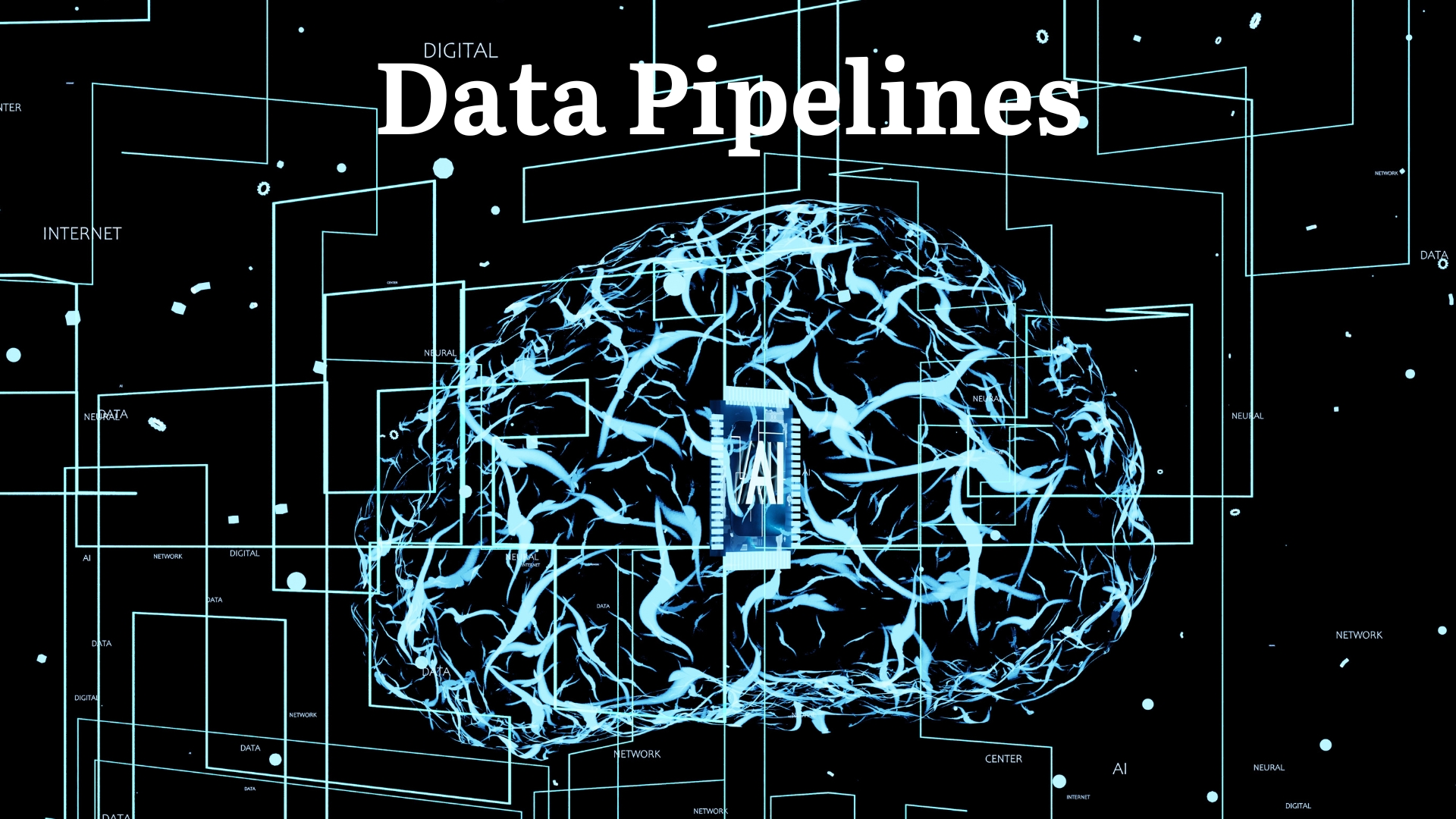In the heart of MLOps lies the data pipeline, the critical infrastructure that feeds data through the various stages of the machine learning (ML) lifecycle. Optimizing these pipelines for efficiency and performance is crucial for building robust, scalable, and cost-effective ML solutions. This chapter delves into key strategies and also considerations for achieving optimal data pipeline performance in the MLOps environment.
ML Pipeline Challenges: Optimizing Data Flow in MLOps
Data pipelines are the workhorses of MLOps, facilitating the flow of data through the various stages of the machine learning (ML) lifecycle. While they are essential for building and deploying ML models, navigating the challenges they present is crucial for achieving robust, scalable, and also cost-effective solutions. Here’s a deeper exploration of the key challenges associated with data pipelines:
1. Scalability- Growing Data Volumes and Model Complexity:
- Growing data volumes: As the volume and variety of data used in ML projects increase, pipelines need to adapt and handle the additional workload without compromising performance. This can be challenging, as traditional pipeline architectures often struggle to scale efficiently, leading to slower processing times and also potential bottlenecks.
- Model complexity: Modern ML models are becoming increasingly complex, requiring more data and computational resources for training and inference. Data pipelines need to be flexible enough to adapt to these evolving needs, scaling resources and also processing power efficiently to accommodate the demands of intricate models.
2. Data Complexity- Data Format and Integration Challenges:
- Diverse data formats: Modern ML applications often involve data from various sources, including text, images, videos, and sensor data. Each of these data formats has unique characteristics and also processing requirements, making it difficult for pipelines to handle them efficiently. Rigid pipelines designed for specific data types may struggle to adapt to diverse formats, hindering the versatility of the ML project.
- Data integration challenges: Combining data from various sources often presents integration challenges. Data pipelines need to seamlessly integrate and harmonize data from different formats and structures, ensuring consistent and also accurate representation for model training and inference.
3. Maintenance Complexity: Pipelines and Code Management
- Large and intricate pipelines: As ML projects evolve, data pipelines often become increasingly complex, with numerous interconnected stages and dependencies. Managing and maintaining such intricate pipelines can be challenging, requiring significant effort for debugging, troubleshooting, and identifying potential issues.
- Version control and code management: Maintaining proper version control and code management practices becomes crucial for complex pipelines. Tracking changes, identifying dependencies, and ensuring compatibility between different pipeline versions can be difficult without proper code management and also version control procedures.
4. Resource Optimization: Balancing performance and cost
- Cost considerations: Efficient resource utilization is essential for controlling costs in data pipelines, especially when dealing with large datasets or computationally intensive models. Pipelines need to be optimized to utilize resources effectively, avoiding unnecessary processing or overprovisioning of resources, which can lead to significant financial burdens.
- Balancing performance and cost: Striking a balance between achieving optimal performance and minimizing resource consumption is crucial. Implementing resource-intensive optimizations might offer performance improvements but could also lead to increased costs.
Approach to Addressing Challenges in ML Data Pipelines
- Modular design: Break down complex pipelines into smaller, independent modules that can be developed, tested, and also deployed individually. This improves maintainability and simplifies troubleshooting.
- Leveraging MLOps tools and platforms: Utilize specialized MLOps tools and platforms that offer functionalities for pipeline orchestration, version control, and resource management. These tools can streamline pipeline development, deployment, and also monitoring, simplifying complex tasks.
- Continuous monitoring and optimization: Implement continuous monitoring practices to track pipeline performance, identify bottlenecks, and optimize resource utilization. Regularly review the pipeline and adapt it as needed to maintain efficiency and performance.
- Employing cloud-based solutions: Leverage cloud-based platforms that offer auto-scaling features and on-demand resource allocation. This allows for dynamic scaling of resources based on pipeline demands, optimizing resource utilization and also minimizing costs.

Optimizing Data Pipelines for Efficiency and Performance:
MLOps professionals constantly strive to create efficient and performant data pipelines, the backbone of successful ML model development and deployment. While the previous section outlined some key strategies, let’s delve deeper into each approach and also explore their nuances.
1. Efficient Data Partitioning for parallel Processing:
- Splitting the Workload: Large datasets can be overwhelming for a single computing node, leading to longer processing times. Data partitioning comes to the rescue by splitting the massive dataset into smaller, manageable chunks. These chunks can then be processed in parallel across multiple computing nodes in a cluster. This significantly reduces the overall processing time compared to sequential processing where the entire dataset is handled by a single node.
- Distributed Processing Frameworks: Leveraging powerful distributed processing frameworks like Apache Spark or Ray further enhances parallel processing capabilities. These frameworks efficiently distribute the workload across the available cluster nodes, ensuring optimal resource utilization and also significantly faster processing times.
2. Efficient Data Compression and Optimization Techniques:
- Reducing Overhead: Data movement within the pipeline can be a significant bottleneck, impacting efficiency. Data compression techniques like Gzip or Bzip2 offer a solution by reducing the size of the data being transferred. This leads to smaller data packets, faster network transmission times, and also reduced storage requirements.
- Choosing the Right Format: Not all data formats are created equal. Selecting data formats optimized for efficient storage and also retrieval is crucial. Columnar formats like Parquet store data in columns instead of rows, allowing for faster access to specific data subsets needed for specific tasks during processing. This significantly improves data processing time compared to traditional row-based formats like CSV.
3. Efficient Processing- Caching and Lazy Evaluation:
- Reducing Redundant Work: Certain data or intermediate results might be used repeatedly throughout the pipeline. Caching these elements eliminates the need for unnecessary recalculations and significantly improves pipeline efficiency. By storing frequently accessed data or intermediate results after the initial computation, subsequent pipeline steps can access this cached information instead of performing the same calculations again.
- Optimizing Code Execution: Lazy evaluation delays certain computations until they are necessary. This allows the pipeline to skip steps that might not be relevant based on conditional operations, optimizing resource utilization and also preventing unnecessary processing. For instance, in a complex pipeline where some data transformations might only be needed under specific conditions, lazy evaluation ensures these transformations are only performed if those conditions are met.
4. Resource Management & Monitoring- Dynamic Allocation:
- Dynamic Resource Allocation: Cloud platforms offer auto-scaling features or container orchestration platforms like Kubernetes that dynamically allocate resources based on pipeline demands. This ensures efficient resource utilization by scaling resources up when needed for intensive processing tasks and also scaling them down during idle periods, optimizing costs.
- Identifying Bottlenecks: Continuous monitoring of pipeline performance metrics is essential for identifying bottlenecks and also areas for improvement. Metrics like execution time, resource utilization, and data processing efficiency provide valuable insights into the pipeline’s health. Additionally, profiling tools can pinpoint specific sections of the code or specific data processing steps that contribute most significantly to execution time. Addressing these identified bottlenecks through optimization techniques can lead to substantial performance gains.
5. Streamlining Workflow- Specialized Tools and Libraries:
- Streamlining Workflow: Dedicated MLOps platforms or tools offer built-in functionalities for data lineage tracking, version control, and pipeline orchestration. These features streamline the development, deployment, and monitoring of data pipelines, facilitating efficient management and also reducing development time.
- Leveraging Expertise: Domain-specific libraries designed for specific data processing tasks like image processing (OpenCV) or text processing (NLTK) offer highly optimized implementations for various operations. Utilizing these libraries within the pipeline can significantly improve data processing efficiency and also performance compared to writing custom code from scratch.
6. Optimizing the Code- Efficient Algorithms & Profiling:
- Writing Efficient Code: Reviewing and optimizing the code written for data processing tasks is essential for achieving optimal performance. This involves implementing efficient data structures like hash tables or dictionaries for faster data retrieval, choosing appropriate algorithms best suited for the specific task at hand, and avoiding unnecessary calculations or redundant operations that might introduce processing overhead.
- Profiling for Targeted Optimization: Profiling tools can analyze code execution and also pinpoint sections that contribute significantly to execution time. These “hot spots” should be the primary focus of optimization efforts. By focusing on these critical code sections and implementing optimizations (e.g., algorithm selection, code refactoring), significant performance improvements can be achieved.
7. MLOps Best Practices- Modular Design, CI/CD, Documentation:
- Modular Design: Breaking down complex pipelines into modular components promotes flexibility, maintainability, and also easier deployment. Each component can be developed, tested, and deployed independently, allowing for faster iteration cycles and easier troubleshooting in case of issues.
- Continuous Integration and Delivery (CI/CD): Implementing a CI/CD pipeline specifically for data pipelines allows for automated testing, version control, and deployment. This ensures consistent performance across deployments and facilitates rapid iteration cycles for continuous improvement. Automated testing catches potential issues early, and also version control allows for reverting to previous versions if necessary.
- Documentation and Logging: Maintaining clear documentation of the pipeline design, data processing steps, and optimization choices made is crucial for understanding and maintaining the pipeline. Comprehensive logging practices capture details about pipeline execution, enabling troubleshooting and also identifying potential issues efficiently.
Strategies of ML Data Pipelines Modular: Cost, Quality, Security
- Cost-efficiency: While optimizing performance is crucial, it’s equally important to consider the cost implications of various approaches. Evaluate trade-offs between performance gains and also associated costs of resources or specialized tools.
- Data Quality and Integrity: Optimizing pipelines shouldn’t come at the expense of data quality or integrity. Implement robust data validation and cleaning steps throughout the pipeline to maintain data accuracy and prevent issues downstream that could impact model performance.
- Monitoring and Alerting: Set up comprehensive monitoring systems to detect pipeline failures, performance anomalies, or data quality issues. Implement automated alerts to notify relevant personnel promptly, facilitating rapid response and also resolution.
- Data Security and Privacy: Adhering to data security and privacy regulations is paramount. Implement appropriate security measures throughout the pipeline to protect sensitive data, including encryption at rest and in transit, access control mechanisms, and regular security audits.
- Testing and Validation: Thoroughly test and validate data pipelines after any modifications are made. This ensures the pipeline functions as expected and also produces accurate results before deployment to production environments.
Advanced Techniques for Large-Scale Data Pipelines in ML:
For large-scale data pipelines handling massive datasets or complex models, additional techniques can further enhance performance and scalability:
- Data streaming: Processing data in real-time or near real-time using streaming frameworks like Apache Kafka or Apache Flink enables continuous analysis and avoids storing the entire dataset at once. Real-time processing optimizes data flow, enabling instant insights and also rapid response to evolving trends and patterns.
- Model parallelism: Parallelize model training across multiple GPUs or machines to accelerate the training process significantly, especially for computationally intensive models. Harnessing distributed computing power optimizes model training, speeding up iterations and enhancing model accuracy.
- Data versioning and lineage tracking: Implementing robust data versioning and lineage tracking practices becomes even more crucial for managing complex pipelines with diverse data sources and transformations. This ensures traceability and allows for rolling back to previous versions if necessary. Ensuring comprehensive version control and lineage tracking safeguards data integrity and also facilitates audit trails for regulatory compliance.
Building, maintaining, and optimizing data pipelines are integral aspects of successful MLOps practices. By employing the strategies and considerations outlined in this chapter, MLOps professionals can ensure their data pipelines are efficient, performant, and scalable, supporting the development and deployment of robust AI solutions. Continuously monitoring performance, evaluating new technologies, and also adapting practices to evolving needs will ensure your data pipelines remain reliable and efficient, propelling your MLOps initiatives forward.
Conclusion: Enhancing Efficiency in MLOps with ML Pipeline
Optimizing data pipelines for efficiency and performance is paramount in MLOps to ensure the seamless flow of data throughout the machine learning lifecycle. Challenges such as scalability, data complexity, maintenance intricacies, and also resource optimization require a multifaceted approach for effective resolution.
By implementing strategies like modular design, leveraging MLOps tools, continuous monitoring, and employing cloud-based solutions, MLOps professionals can address these challenges effectively. Techniques such as efficient data partitioning, compression, caching, and also lazy evaluation enhance pipeline performance, while adherence to MLOps best practices ensures streamlined workflows and robust pipeline management. Moreover, considerations regarding cost-efficiency, data quality, security, and testing further contribute to the optimization efforts.
Frequently Asked Questions
1. What is the role of data pipelines in MLOps?
Data pipelines facilitate the flow of data through various stages of the ML lifecycle, essential for building and deploying ML models.
2. What are the main challenges in optimizing data pipelines?
Challenges include scalability issues with growing data volumes and complex models, data format diversity, maintenance complexities, and resource optimization for balancing performance and cost.
3. How can MLOps professionals address scalability issues in data pipelines?
Strategies like modular design, leveraging MLOps tools, and employing cloud-based solutions enable efficient scaling of resources based on pipeline demands.
4. What techniques enhance the efficiency of data processing within pipelines?
Techniques include data partitioning for parallel processing, efficient compression and optimization, caching, lazy evaluation, and resource management through dynamic allocation.
5. What best practices should be followed for robust pipeline management?
Best practices include modular design for flexibility and maintainability, continuous monitoring, adherence to CI/CD principles, comprehensive documentation, and rigorous testing and validation.
6. How can MLOps professionals ensure data integrity and security in pipelines?
By implementing robust data validation and cleaning steps, maintaining appropriate security measures such as encryption and access control, and adhering to data security and privacy regulations.
Keywords: ml pipeline | ml pipeline architecture | Machine Learning Techniques | Machine Learning pipelines | AI









